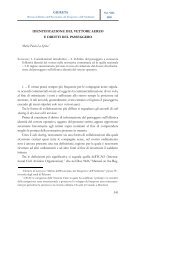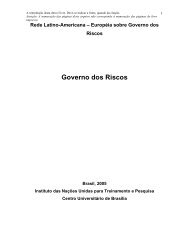Rome II and Tort Conflicts: A Missed Opportunity Abstract Contents
Rome II and Tort Conflicts: A Missed Opportunity Abstract Contents
Rome II and Tort Conflicts: A Missed Opportunity Abstract Contents
You also want an ePaper? Increase the reach of your titles
YUMPU automatically turns print PDFs into web optimized ePapers that Google loves.
SYMEON C. SYMEONIDES ROME <strong>II</strong> AND TORT CONFLICTS<br />
American court of last resort ab<strong>and</strong>oned the lex loci rule involved the commondomicile<br />
pattern. Subsequently, an additional 18 common-domicile cases have<br />
reached the highest courts of the states that had previously ab<strong>and</strong>oned the lex loci rule,<br />
thus raising to 50 the total number of common-domicile cases that have reached state<br />
supreme courts in the post-lex loci era. Of these 50 cases, 44 cases (or 88%) have<br />
applied the law of the common domicile, regardless of the particular choice-of-law<br />
111<br />
methodology the court followed. The majority of these cases (35 out of 50) involved<br />
the Babcock v. Jackson pattern in which the law of the common domicile favors<br />
recovery more than the law of the state of conduct <strong>and</strong> injury. These cases present the<br />
classic false conflict paradigm in which only the state of the common domicile has an<br />
interest in applying its law. The remaining cases involved the converse-Babcock<br />
pattern in which the law of the common-domicile prohibits or limits recovery more<br />
than the law of the state of conduct <strong>and</strong> injury. These cases are not as clear false<br />
conflicts as Babcock was because the accident state arguably has an interest in<br />
applying its law to compensate those injured in its territory <strong>and</strong> to facilitate recovery<br />
112<br />
of local medical costs. On balance, however, the application of the law of the<br />
common domicile in both the Babcock pattern <strong>and</strong> its converse is entirely justified.<br />
In this sense, a common-domicile rule that does not depend on the content of the law<br />
of the common domicile (i.e., a jurisdiction-selecting rule) is generally preferable to<br />
any other iteration.<br />
It is important to stress, however, that all of the above American cases<br />
involved conflicts between “loss-allocation” or “loss-distribution” rules, as opposed<br />
to “conduct-regulation” rules. In contrast, the common-domicile rule of <strong>Rome</strong> <strong>II</strong> is<br />
much broader in that it encompasses not only loss-distribution issues, but also<br />
conduct-regulation ones. This is a serious defect. As a general proposition, a state has<br />
an interest in enforcing its conduct-regulating rules even if neither the violator nor the<br />
victim is domiciled in that state, <strong>and</strong> even if both parties are domiciled in the same<br />
foreign state. For example, an Austrian motorist involved in a French accident may<br />
not claim exemption from French traffic rules, <strong>and</strong> if injured by conduct that violates<br />
these rules, France may not deny her the benefit of their protection. Even if both<br />
parties are domiciled in Austria, France has the exclusive claim to apply its law to the<br />
conduct-regulating aspects of the case. These aspects are not limited to rules of public<br />
law or pure traffic rules such as speed limits <strong>and</strong> red lights; they also extend to rules<br />
that impose civil liability to violations of traffic rules or attach presumptions <strong>and</strong><br />
inferences of fault that arise from certain violations, such as not maintaining sufficient<br />
distance from the preceding car. Because the common-domicile rule of <strong>Rome</strong> <strong>II</strong> is<br />
110. (...continued)<br />
LAWS, 799-806 (4th ed. 2004).<br />
111. The six cases that applied another law are distinguishable, overruled, or discredited. See<br />
SYMEONIDES, THE CHOICE-OF-LAW REVOLUTION, 149 n.17, 152-54.<br />
112. See id. at 154.<br />
56 AMERICAN JOURNAL OF COMPARATIVE LAW (2008) PAGE 23 OF 46



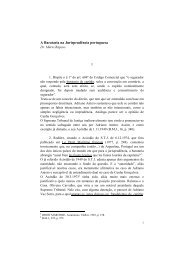

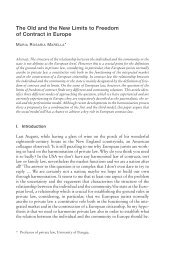


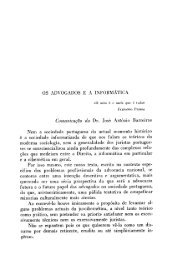
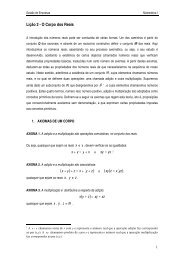

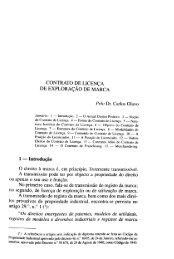
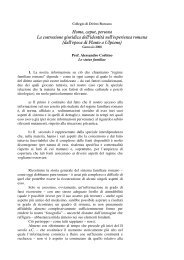
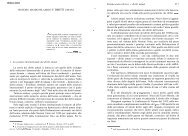

![Luigi Sapio Nozione di islām La parola “islām” [ ] è il mas.dar1 ...](https://img.yumpu.com/15836073/1/185x260/luigi-sapio-nozione-di-islam-la-parola-islam-e-il-masdar1-.jpg?quality=85)
